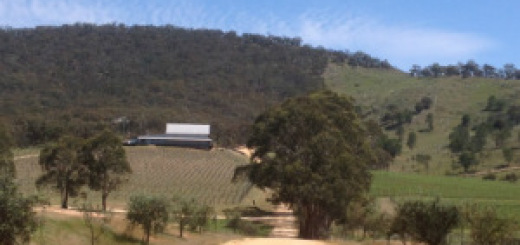Miltenberg – a half-timbered paradise.
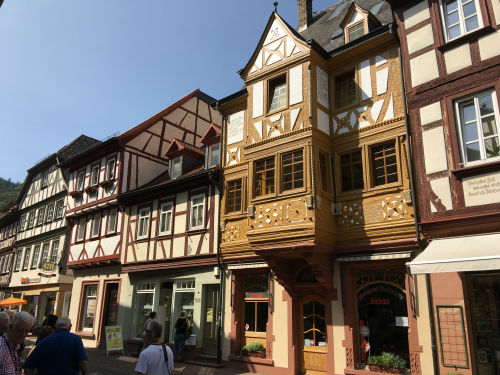
Less well known than the Rhine and the Danube, the Main (pron. ‘mine‘) offers many landscape and cultural highlights as it winds its way past picturesque towns like Miltenberg, one of the prettiest and best preserved medieval cities on the Main. Miltenberg belongs to the historic region of Franconia, but was incorporated into the state of Bavaria in 1816. If you like half-timbered buildings there are well over a hundred to feast your eyes on.

We met our local guide on the Hauptstrasse (High Street) and strolled from near the Würzburg Gate (c.1379) at one end of the town, right along to just beyond the old market place, admiring the architecture and being regaled with amusing stories. This very long street extends about 2.5 kilometres parallel to the river as far as the Mainz Gate, with many buildings dating back to the 15th and 16th centuries in a wonderful state of preservation.

Along with the humour was a little pathos, as our guide explained to us the fate of the Jewish community of Miltenberg in 1942. On the cobblestones in front of houses we occasionally saw these bronze plaques or Stolpersteines (stumbling blocks). They are a project by artist Gunter Demning to honour the lives of the Jews who had lived there and were deported to concentration camps and who died there, usually very soon afterwards. The plaques keep their memory alive with their names, dates of birth and deportation and when possible the name of the camp and the date of death. HY”D
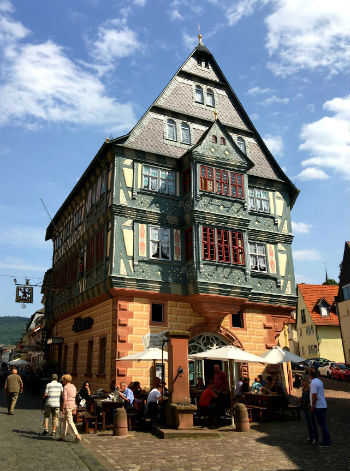
One gem of a building is the restored Hotel zum Riesen or Giant’s Inn, which was built in its present form about 1590 and is said to be one of Germany’s oldest taverns, having a licence dating back to 1411. The medieval hotel sign hanging at the left bears a giant wielding a sword and the Star of David symbol hangs below noting that in those days the owners were Jewish. The small square in front was apparently the site for the burning of witches. Back in the 17th century, Bavaria was gripped with an hysteria about witches. Between 1626 and 1629 there were 168 people executed in Miltenberg alone for being a witch.

Further along the high street the picture book architecture continues with a large red sandstone building – the old Rathaus (c. 1379) or town hall, now superseded by another on Engelplatz. In the distance, a white Renaissance style building which houses a museum of icons and contemporary art looms large above the streetscape. This is a later addition to the Mildenburg Castle behind, constructed over 800 years ago and currently undergoing restoration.
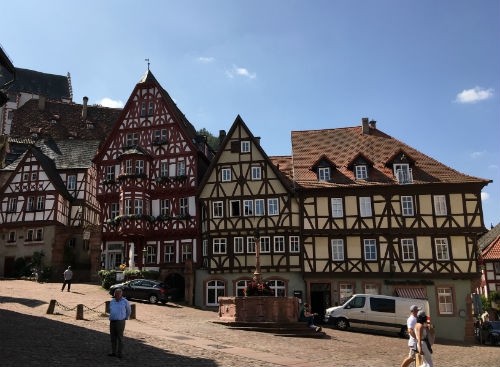
At the heart of town is the old main square or Alter Marktplatz, better known as the Schnatterloch. At its centre is a fountain dating from 1583, built from the local red sandstone. The markets held here brought trade from the surrounding area, bringing much wealth to the town. Apart from the stone industry, another reason for the town’s prosperity was its role in the wine trade. Miltenberg itself lies on the edge of the Odenwald (forest) on a narrow tract of land by the river, but nearby villages produce fine red wine called Spätburgunder (Pinot Noir). Nowadays, the Rotwein Wanderweg (Red Wine Trail) passes though Miltenberg, giving enthusiasts a chance to savour more varieties such as Domina, Dornfelder and Regent.

Also on Marktplatz is the City Museum, in a house built in 1541, which has exhibits demonstrating aspects of the area’s history spanning Celtic and Roman times up to the present. Further up the hill is the Schnatterloch tower, built about 1453 as a guard tower. The lane passes through a gate in the tower and leads up to the Mildenburg Castle.
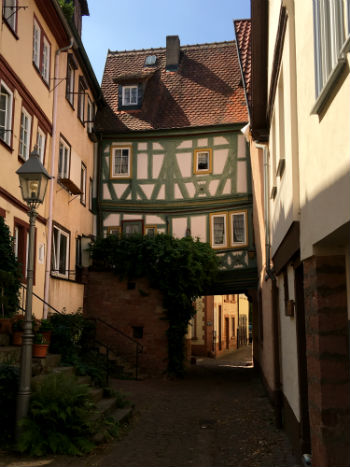
Further west along the main street the lanes become so narrow and the mountains cast such a shadow, that little light is able to illuminate the streets of the oldest part of town, hence its nickname – the Schwarzviertel (Black Quarter). This sagging house was built in an attempt to avoid paying land tax, as it is largely suspended from its neighbours’ houses.
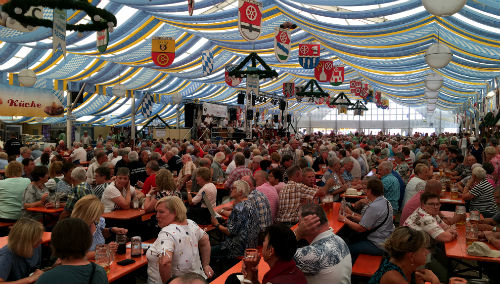
The cruise ship tourists were not the only ones in Miltenberg at this time. It was the lead up to Germany’s love affair with beer – the Octoberfest. Miltenberg was in the throes of its own beer fest, as we soon discovered. This beer hall tent was jammed full of enthusiasts with barely a spare seat available. The heat from the cooking stations and noise from the band, announcements and chatter in there was unbearable, so we looked elsewhere for refreshments.

In more pleasant surroundings alongside the river we found stalls selling beer and würst (sausage), so we took time to join in the festivities there and rest our weary feet, before heading back to meet our guide again. “A hard earned thirst needs a big cold beer”, so they say!
Then it was off to nearby Wertheim by bus with our guide for more stories and jokes and more gorgeous old architecture.


